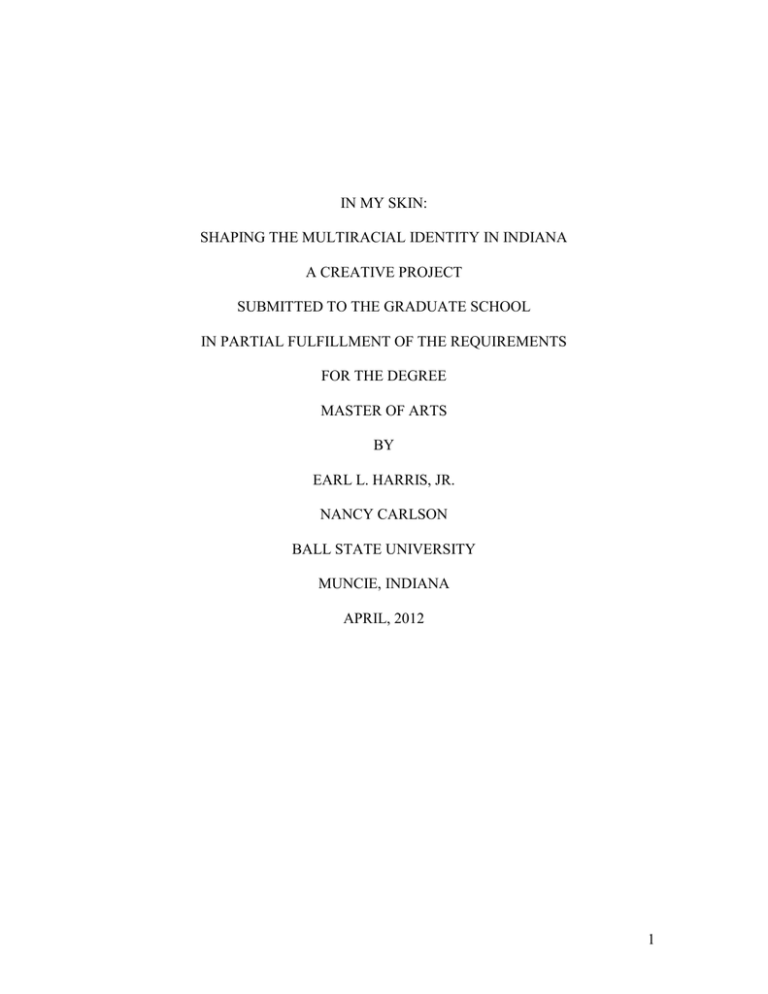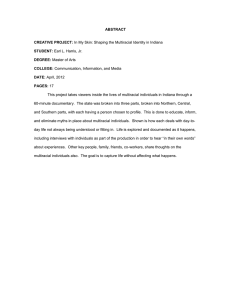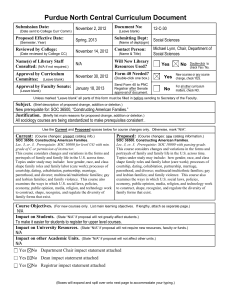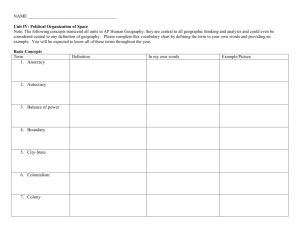IN MY SKIN: SHAPING THE MULTIRACIAL IDENTITY IN INDIANA A CREATIVE PROJECT
advertisement

IN MY SKIN: SHAPING THE MULTIRACIAL IDENTITY IN INDIANA A CREATIVE PROJECT SUBMITTED TO THE GRADUATE SCHOOL IN PARTIAL FULFILLMENT OF THE REQUIREMENTS FOR THE DEGREE MASTER OF ARTS BY EARL L. HARRIS, JR. NANCY CARLSON BALL STATE UNIVERSITY MUNCIE, INDIANA APRIL, 2012 1 Part 1 The number of interracial marriages and couples is growing. The Supreme Court decision in 1967 which deemed racial segregation laws unconstitutional played a big role. Marriage between people of two different racial groups has led to an increase in the number of multiracial/multiethnic children born. While growing up can be challenging for anyone, being multiracial/multiethnic can bring about some unique challenges and experiences, not all of which are negative. Note. From Wang, W (2012) ‘The Rise of Intermarriage’ Pew Research Center, online http://www.pewsocialtrends.org/2012/02/16/the-rise-of-intermarriage/2/ 2 “Marriage across racial and ethnic lines continues to be on the rise in the United States. The share of new marriages between spouses of a different race or ethnicity increased to 15.1% in 2010, and the share of all current marriages that are either interracial or interethnic has reached an all-time high of 8.4%. In 1980, just 3% of all marriages and less than 7% of all new marriages were across racial or ethnic lines. Both of those shares have more than doubled in the past three decades” (Wang, 2012). Note. From Wang, W (2012) ‘The Rise of Intermarriage’ Pew Research Center, online http://www.pewsocialtrends.org/2012/02/16/the-rise-of-intermarriage/2/ The President, the Golfer, and the Actress 3 Two important factors in need of in-depth examination among multiracial/multiethnic adolescents are ethnic identity and self-esteem of the individual. Over the past decade numerous books, journals, and articles have been written on interracial issues. The election of President Barack Obama, a multiracial/multiethnic person, has brought pride to individuals of diverse heritage. His election has given parents of multiracial/multiethnic children someone they can identify for their offspring to admire. “For the parents of multiracial/multiethnic children, Obama's rise has been a vindication of sorts, a presidential rebuttal to a society that has not always been kind to its offspring” (Terry, 2008). While our President has gotten a lot of attention for his multiracial/multiethnic background, many other individuals, like Tiger Woods, the most famous golfer/athlete in the world, award winning actress Halle Berry, and singer Joan Baez, have made great achievements. Tiger’s story is made even more interesting by the fact that he is extremely successful in a sport that has been dominated by whites. Also, add to the fact that he is a multiracial/multiethnic person previously in a multiracial marriage, which led to the birth of multiracial/multiethnic children of more races than Tiger himself. What about the multiracial/multiethnic children of the multiracial/multiethnic? Multiracial/multiethnic offspring of multiracial/multiethnic people is another group that has received little attention. Discussion about whether or not parents that are multiracial/multiethnic can help make it easier for their children is a topic that can be discussed. 4 Halle Berry is known as the first African-American to win the Best Actress Oscar. The truth is she is the first multiracial/multiethnic person to win the Best Actress Oscar. Her success makes her a great role model for multiracial/multiethnic people. Like Tiger Woods, she is multiracial/multiethnic parent of a multiracial/multiethnic child. The Chosen Subjects This project takes viewers inside the lives of three multiracial/multiethnic individuals located in Indiana through a 60-minute documentary. A person was chosen and profiled from three parts of the state. Indiana was broken up into northern (north of Muncie), central, and southern (south of Martinsville) for the choices made. The people profiled reflect differences in their racial make-up, meaning they are of different genders, race combinations, as well marital status, and careers. The choice to have people at different points in lives was made in an effort to educate, inform, and dispel myths about multiracial/multiethnic individuals. One of the selected, Maria, I have known most of her life which means I am well aware of her story. She is the only one that is married and has children. I had previously met Nicole, but was originally not aware of her multiracial/multiethnic background. Eric was recommended to me after having a conversation with Indiana University Sociology Professor Dr. Brian Powell. I originally spoke to Dr. Powell, after discovering he has written about family and inter-racial composition, about being part of the show documentary. After speaking with Eric, I felt his story added new and interesting elements not always 5 present. Included in those facts are that Eric is the only one of the three not born and raised in Indiana. A community leader and professional engaged in multicultural education are also utilized in the production. They provide information as individuals experienced in working with multiracial/multiethnic persons. Their involvement also allows for information and understanding by some whom have studied this section of society and have some influence on how it is treated. Misinformation about multiracial/multiethnic people abounds. “They are confused about whom they are.” and “They don’t belong to any group.” are a couple of incorrect statements made. This project will have an effect on society by taking viewers inside the lives of multiracial/multiethnic individuals. Hearing directly from the individuals and those around them will help tell the true story of their lives. Note. (2010) United States Census 2010, online http://2010.census.gov/2010census/data/ Part 2 As so many processes can be, this one has been a learning experience. One of the things that I learned is that there has been more written on multiracial/multiethnic individuals than I previously knew existed. The writings have come in all forms, journals, books, magazine articles, and even websites. I was most surprised by the number of websites that highlight the lives of 6 multiracial/multiethnic individuals and groups. Included in that is the discovery of groups and events held. The Mixed Roots Film and Literary Festival brings together multiracial/multiethnic people to celebrate stories of their experiences through films, literature, and performances. This could serve as a future outlet for the final product. A lot of multiracial/multiethnic research covers this section of society in a broader sense, not focusing on individuals, but more on larger sections such as adolescents, children, or multiracial/multiethnic people in general. The uniqueness of focusing on individuals in one state, Indiana, extends what others have done on this topic. As we know, diversity is more accepted than it once was in this country. “About six-in-ten Americans say they like the idea of living in politically, racially, religiously or economically mixed communities. Virtually all major groups, at least to some degree, choose diversity over homogeneity when asked where they would like to live” (“Americans Say They Like Diverse Communities,” 2008). In a state with the history of race relations that Indiana has, the value of the project is increased. Indiana was home of the first black millionaire, Madame C.J. Walker and was part of the early beginnings of the Ku Klux Klan. “During the 1920s, five million Americans joined the Ku Klux Klan. Hoosiers turned out in record numbers, making Indiana 's Klan the largest, most enthusiastic, and most politically powerful Klan in the country. Between one-fourth and one-third of native-born white Hoosier males joined the group and there were auxiliary organizations for women 7 and children. At its peak in 1925, Indiana's Klan could boast more members than the Methodist Church, the state's leading denomination” (“A Closer Look at,). Documentary Production The pace of the production is fast moving and contains strong visuals. People will be interested in the stories, but will also want them delivered in an interesting way. Motion graphics, animation, and music are assets used to help with the quality of a television production. Gone are the days of “dry” documentaries that contain only basic video shots and interviews. Documentaries now take on the look of a production once only thought to be seen in entertainment productions. Mine has the same quality and designed to engage the audience so they can learn from the stories told. Part 3 One of the focus areas of the creative project is the socialization and identity of multiracial/multiethnic individuals through their family life. The interracial family is the cradle of the multiracial/multiethnic person’s identity development. In some instances the family helps shape the person’s perception of himself/herself and the world through positive messages. In some instances, multiracial/multiethnic children are the victims of their parents’ racial identities and the baggage that comes with that. Does the multiracial/multiethnic person adopt a mono-racial or multiracial/multiethnic identity, and what influences the decision? How does the multiracial/multiethnic person deal with the prying question, “What are you?” 8 Another key area of focus is to look at myths about multiracial/multiethnic individuals. The program gives the individuals an opportunity to share their feelings on these myths and share whether they agree or disagree. Also, we will find out their thoughts on whether or not this type of thinking is valid or insulting to them, knowing that non-multiracial/multiethnic people are not faced with the same myths. The documentary looks into how our subjects experience life as multiracial/multiethnic persons in Indiana. A key reason that people from multiple parts of the state were chosen is to find out if there is a difference in perception in diverse segments of the state. The capital city of Indianapolis has a diverse population, while other parts of the state do not. What does that mean if one part of your background fits the majority, but the other does not? Also, what if you look like the minority side...does this play a role in your life as a multiracial/multiethnic person? The Approach The approach of the taping is documentary style. The structure observes the behaviors of multiracial/multiethnic individuals. We learn how each person deals with day-to-day life in not always being accepted by others. We explore and document life as it happens. Individuals are interviewed on-camera as part of the production in order to hear “in their own words” about life. Other people in our main subjects’ lives…family, friends, co-workers, share their thoughts on the multiracial/multiethnic individuals. 9 I have not attempted to direct the families’/individual’s activities nor encouraged them to act in any particular way. The goal is to capture life without affecting what happens. Producing a documentary fit perfectly into the goal of sharing real, unscripted information with viewers about this section of the population. By successfully avoiding influencing the narratives, I will ensure that the individuals’ true stories will be captured and told in their words. Part 4 My goal was to reveal the lives led by multiracial/multiethnic people, to clear up misconceptions, and to show the real experience of mixed race people. The individuals in the documentary, while diverse in their backgrounds, have all had some sort of issues surrounding being multiracial/multiethnic as they were growing up, but all seem to have turned out to be successful adults. They have not only accepted their multiracial/multiethnic backgrounds and what they mean, but have also learned to enjoy this distinction. There is More Story to Tell The scope and size of this project is rather large. While I am happy with the documentary, more could have been done. The project has taken place over a small window of time and had limited funding. I would like to have more time and money to take a more in-depth look at the subjects’ lives. I would capture how they experience being out in public. How do people look at them and act towards them? When negative interactions happen, what does the person do and how does the person really feel at that moment? Something closer to a year would be more effective, 10 allowing for the capturing of people in even more situations, including holidays, when family time would really come into play. I also think that I might have tried to cover too much information in the show. Perhaps a more focused look at certain aspects of their lives would have allowed for more in-depth information. A major area like family life was covered, but not in a sufficient way. We did not speak with an equal number of family members for each of our people. More family involvement would have brought about more insight into them from their youth until adulthood. The biggest recommendation I have for future projects is to focus on particular aspects of their lives. As an example, focus just on family life. Take a look at their lives from a young age. Really get into what it was like when they were children and what they experienced having two distinctly different racial/ethnic backgrounds meant as the aged. This work could explore whether there were major issues or if everyone on both sides came together happily. Some questions to explore would be: How did having or not having siblings play a role in their growth? How was life growing up as they progressed toward adulthood? Did getting older change dynamics, make things better or worse? Included in the study should also be, for those married and/or with children, what the addition of a second generation or new family members means to the dynamic of relationships with relatives. When you bring in new factors, such as new people into the family equation, it has to affect the situation. 11 Time also leads to revelations about family dynamics that the main subjects did not know or were not informed of during their childhood. Family dynamics not shared with a young child, but discovered as an adult play a role in the study. Does this information change their perception of themselves and the people they call family? Another area to add to the study is the dynamic of whether or not a multiracial/multiethnic person has both parents in his/her life. Having only one parent means a lot to anyone, but can bring more to the study of multiracial/multiethnic people. Something as simple as a name that sounds like it comes from the background of the missing parent to whether or not the person looks like the parent in their life can play huge role. Multiracial/multiethnic individuals are a rather expansive area to study. Although they have much in common with monoracial people, there are many aspects of their lives that can be explored on deep levels. What my project has shown is that there is plenty of information present, but even more that can be uncovered. Added research and more focus can help improve the project and also help show that one 60-minute documentary is not enough to truly show life as a multiracial/multiethnic person in Indiana. Perhaps this is just a start to what will become an ongoing series, which will let viewers learn more about this segment of our society. Literature Review 12 There is a lot of attention given in literature to multiracial/multiethnic people of the black and white combination. “I Was Black When It Suited Me ;I and Was White When It Suited Me", and “Mixed: My Life in Black and White” are two examples of resources that focus primarily on black/white combinations. While black/white combinations are seen most in the history of this country, the truth is many other combinations exist A change, however, is occurring in this topic area. Writers are now looking into and writing about other multiracial/multiethnic backgrounds. Multiracial/multiethnic children of Hispanic, Asian, and other backgrounds are drawing attention. “Demographer Reynolds Farley of New York City’s Russell Sage Foundation estimates that these young people currently number at least four million. About a quarter of them are of black and white parentage, but the majority-about 70 percent-come from homes where one parent is white and the other is Asian-American, Hispanic, or Native American” (Associated Press, 2007). Does it lead to negative feelings like depression or not feeling accepted? Do they participate in extracurricular activities? Whom do they look for to make friends? “A girl from Nevada says she was called ‘half-breed’ and ‘Oreo” by black teenagers. A boy from Tennessee was rejected by white relatives who couldn’t accept his African-American heritage” (Ibid.). The psychological part of the multiracial/multiethnic experience is discussed in many writings. Self-esteem plays a role in how a person deals with differences that may occur. We are taken inside the individuals to learn more 13 about self-perceptions. The development of a personal identity for some multiracial/multiethnic individuals has been harder than others. Education is explored in many of the literature pieces. As with all young people, a great deal of time is spent at school. Much socialization occurs in this environment. Many writings delve into how multiracial/multiethnic individuals relate when it comes to acceptance at school. “In other words, students have the tendency to form friendships with students who are similar with respect to race” (Doyle, Grace, 2007). Acceptance by school peers is relevant due to the importance put on “fitting in” as an adolescent. We hear the voice of the multiracial/multiethnic people, as well as the voices of their parents. Parent’s influence on their children’s lives is enormous. Parents are big difference makers in how multiracial/multiethnic children view themselves throughout life. Parents discuss decisions they must make to help their child make it through life (Kilson, 2009). The role of parents is important in any child’s life, whether of one race or multiple races. Mothers of biracial children cite the challenges presented by their children’s racial identity and thoughts of ambiguity. Some parents had expectations about the racial identity of their children. Genetic surprises leading to different looking children in the same family can occur. We learn about an interesting challenge that some parents had to face. What is it like when siblings’ racial characteristics are different? Parents express what it means when racial characteristics, such as skin color, hair texture, and other physical features are 14 not the same amongst their children. Does this make the experience easier or harder for the families? Parents and their biracial children can have different skin tones, leading to other individuals not always seeing the relationship between them. The title of one piece asks the question “Is that your child?” (Ibid.). A question like this can lead to painful challenges for multiracial/multiethnic parents and the children, especially when dealing with others that may not understand or appreciate when parent and child don’t look alike, but do belong together. Angela Nissel, author of “Mixed: My Life in Black and White” even shares a story of not wanting to go back to a store after the clerk does not originally believe that her father, who is white, is actually her father (Nissel, 2006). Nissel’s story shows a lack of understanding by some of what will be discussed in my documentary. The stories of the main subjects will serve as an opportunity to help others learn. One source focuses on a person in the state of Indiana, Muncie specifically. In Gregory Howard Williams’ memoir, “Life on the Color Line”, we learn about his life as he moved from Virginia to black housing projects of Muncie. Williams, who comes from a white mother and mixed race father, was able to pass for caucasian. His father was thought by Williams to be Italian. After his mother left, abandoning Williams and his younger brother, the boys moved to Muncie along with their father after living a life of white privilege. The move to a predominantly black area is where Williams first became aware of his father's African-American heritage. “Life is going to be different from now on. In Virginia you were white boys. In Indiana you’re going to be colored boys. I want 15 you to remember that you’re the same today that you were yesterday. But people in Indiana will treat you differently” (Williams, 1995). Being multiracial/multiethnic can lead to dealing with prejudice from those that are of totally different races, but also from both groups with they should feel a connection. As cited, the added level of prejudice brings up different challenges for people who may find it hard to deal with not being able to connect with any group (Coleman, Carter, 2007). 16 References Associated Press. (2007, April 15). After 40 years, interracial marriage flourishing. Retrieved from http://www.msnbc.msn.com/id/18090277/. Brunsma, David L. (2006). “Public Categories, Private Identities: Exploring Regional Differences in the Biracial Experience”. Social Science Research, 35 (3): 555-576. Cheng, Simon and Joshua Klugman. (2010). “School Racial Composition and Biracial Adolescents’ School Attachment.” The Sociological Quarterly 51:150-178 Coleman, Victoria H. & Carter, M. (2007). “Biracial Self-Identification: Impact on Trait, Social Anxiety, and Depression”. Identity: An International Journal of Theory and Research 7 (2): 103-114. Crothers, A. Glenn; K'Meyer, Tracy E. (2007). “I Was Black When It Suited Me; I and Was White When It Suited Me": Racial Identity in the Biracial life of Marguerite Davis Stewart”. Journal of American Ethnic History, 26 (4): 24. Doyle, Jamie Mihoko & Kao, Grace. (2007). “Friendship choices of multiracial/multiethnic adolescents: Racial homophily, blending, or amalgamation?”. Social Science Research, 36 (2): 633-653. Edwards, Myrtice J. (2008). Mixed Race kids of All Nations: Raising awareness of the biracial, multiracial/multiethnic, and transracially adopted kids in a race-conscious world, CreateSpace. Indiana Magazine of History. A Closer Look at Indiana’s Klan. Retrieved from: http://www.iub.edu/~imaghist/for_teachers/mdrnprd/lstmp/Klan.html Kilson, Marion. (2009). Is that your child? : mothers talk about rearing biracial children. Lanham, MD : Lexington Books. Nissel, Angela. (2006). Mixed: My Life in Black and White. Villard Are you black or white?" Pew Research Center. (2008, December 2). Americans Say They Like Diverse Communities; Election, Census Trends Suggest Otherwise. Retrieved from: http://www.pewsocialtrends.org/2008/12/02/americans-say-they-likediverse-communities-election-census-trends-suggest-otherwise/ Terry, Don. (2008). The president-elect is “Other” like them. Los Angeles Times, November 28, sec. A. 17 Wang, Wendy. (2012). The Rise of Intermarriage. Pew Research Center. Retrieved from http://www.pewsocialtrends.org/2012/02/16/the-rise-ofintermarriage/#executive-summary Williams, Gregory Howard. (1995). Life on the Color Line. New York, NY: Penguin Books. 18


![[insert organizational header]](http://s3.studylib.net/store/data/007468113_1-a7a4132c2cccee9d2a64f31f82f0e078-300x300.png)



